
Garden Traveling—at Home

Contributor
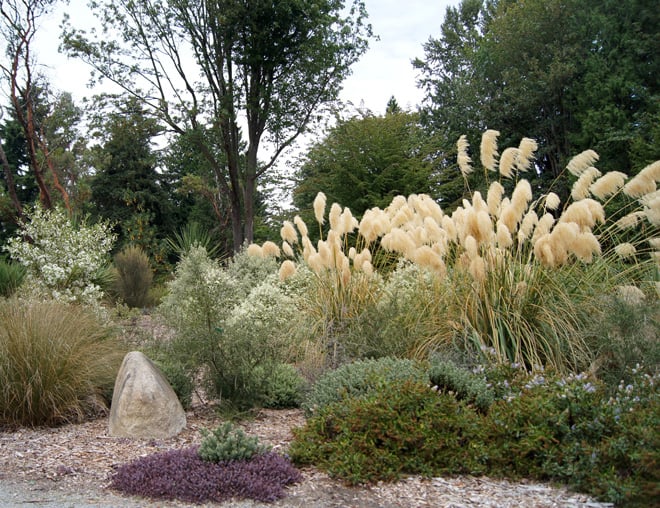
[sidebar]
For more information
University of Washington Botanic Garden
Washington Park Arboretum
Berger Partnership[/sidebar]
Imagine: your face is smeared with blue war paint made from the pollen of Fuchsia excorticata as you grapple the razor-sharp leaves of the lancewood (Pseudopanax crassifolius) to harvest its purple fruit before hungry moas, towering flightless birds, can snatch their next meal from the Dr. Seuss-like trees. Welcome to a forest on New Zealand’s South Island.
As lancewoods outgrow the understory, they shift from toothed terrors to lollypops of fluff. Their leaves lose the thorns—there’s no need for armor once they are taller than the browsers—and change shape from narrow to broad, allowing them to absorb more life-giving sunlight. This adaptation, known as heteroblasty, is a common defense strategy among New Zealand trees. But hold on, we’re not in Otaga province but Washington state, moas are extinct, and lancewood is not reliably hardy in the Pacific Northwest—although it grew 15 feet in six years in my garden before dying.
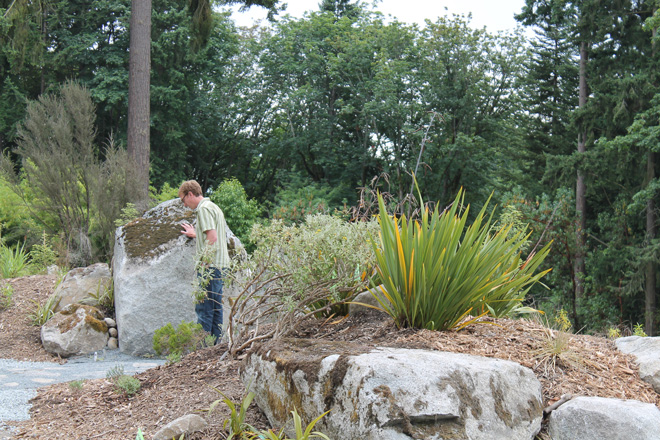
Pacific Connections
Each planting in the new Pacific Connections Garden at Seattle’s Washington Park Arboretum focuses on plants from five different countries connected by the Pacific Ocean at a similar latitude to Seattle, around 48 degrees north or south of the equator. Within each garden, eco-geographic plantings focus on specific areas of plant diversity in each country; for example, Cascadia features Siskiyou Mountain flora, while plants from China’s Mount Emei region are on show in the China garden.
Last summer, the newest of these five focal forests under development in the Pacific Connections Garden was unveiled. The New Zealand Forest is a two-acre site planted with more than 8,000 specimens endemic to the South Island of New Zealand that required the efforts of nurserymen in both countries to collect and grow these unique plants. The result is a living plant museum as well as a strolling park open to the public. The backbone of the new forest consists of three mature specimens of Southern beech (Nothofagus), a tree that naturally occurs only in the Southern Hemisphere and is rarely planted in Pacific Northwest gardens. Transplanted from the Arboretum’s former Entry Garden, these trees link the original New Zealand collection, known as the John Bollard Garden, and the new Pacific Collections Garden. Opening ceremonies held in September 2013 were attended by local New Zealand dignitaries and included a performance by Maori dancers.
Washington Park Arboretum functions as an important part of the University of Washington’s College of the Environment. University of Washington Botanic Garden (UWBG) staff curates and maintains the plant collections as well as conducts on-site research with visiting scholars. Originally, plant collections were taxonomic or grouped by family, but within a given family you may have plants with different cultural requirements, making the taxonomic system impractical. Eco-geographic organization—grouping plants that grow with similar soil and environmental conditions—was an important aspect of the Arboretum’s 20-year Master Plan for redevelopment. The Berger Partnership, a Seattle landscape architecture and urban design firm, became involved with the project in 2008 and today, under leads Jason Henry and Andy Mitton, we are seeing the results on the ground.
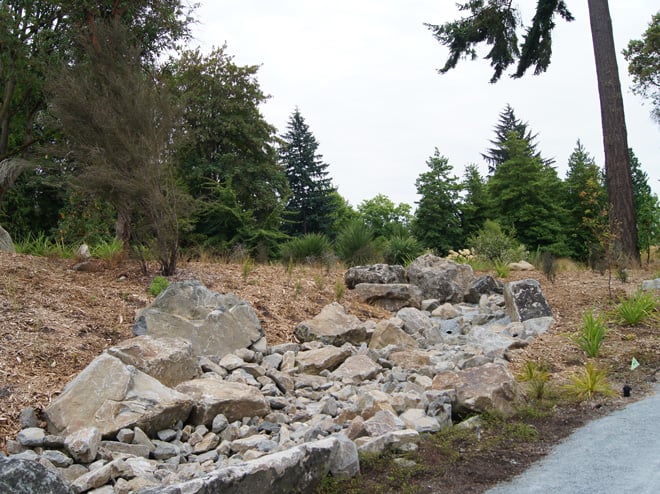
Taming the Site
Reconfiguring the steeply sloped site was critical for garden maintenance as well as allowing visitors of all abilities access to enjoy the garden and its views north toward the University of Washington from the stone lookout. Beautiful rock outcroppings and extensive streambeds, designed by landscape architect Andy Mitton, channel surface water to granite screes and catchment basins to remedy drainage problems on the site. The removal of more than twenty trees, mostly wild trees not a part of the Arboretum collection, improved access and left room for the creation of a stunning mix of Northwest granite and New Zealand natives with a hardscape where the fantasy of architectural drawings meet the realities of rock. Swales of boulders retain changes in elevation while a meandering trail opens the views and organizes the slope into discrete planting areas that can be appreciated from many vantage points.
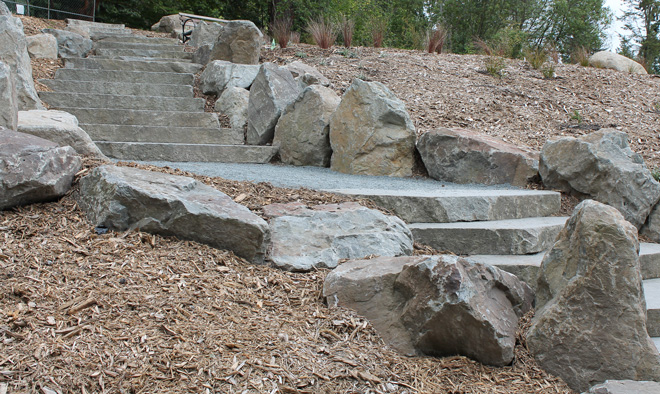
Tertiary paths and informal trails pull visitors into the double helix stair sections near the old Lookout. A new stone stairway is set so each indentation or outcropping of the live-edge treads beautifully aligns with the next. The original boulder looks like it has been sliced and fanned out, an effect Mitton refers to as “butterflied,” linking the fore-edge of one tread with the next like the fanning of wings.
Mitton is sensitive to rock as it appears in its natural setting. The boulders bordering the new stairways are sourced from Hancock Creek near Snoqualmie Pass, and are dug into the soil to mirror the scree elsewhere on the site. Working with an aesthete’s eye and a surgeon’s skill with a rock grappler, Shinda Sidhu of Olympic Rockeries and Construction set the rocks, placing the 1200-pound stair treads within a fraction of an inch; a particularly sensitive task as the slightest misalignment would make this innovative design look shabby.
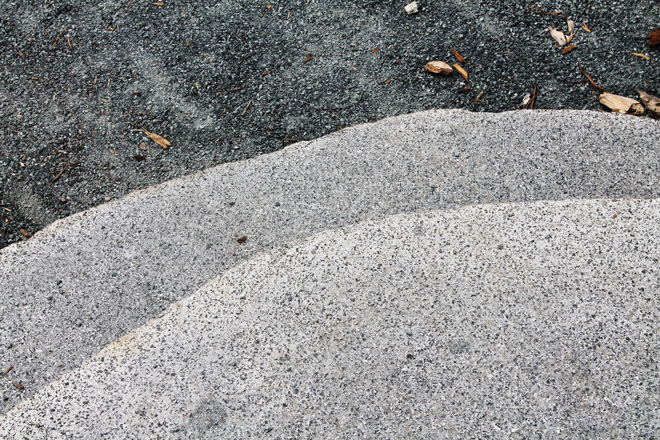
It’s not just the rocks that have been so carefully placed; the plants also reveal careful visual transitions. The exfoliating bark of mountain lacebark (Hoheria glabrata) and tree fuchsia (Fuchsia excorticata) relate to the remaining non-New Zealand collection plants, such as the three stewartias located on the periphery of the Nothofagus forest. The scent of the white Hoheria flowers draws visitors down the slope, and the ultramarine blue to cerise tree fuchsia blossoms invite a closer look. We may even collect some of that blue pollen on our noses while sniffing and searching for the plant’s ripe purple fruits.

Teamwork
Building a garden on this difficult site required patience and flexibility. Project site manager Joel Waymire of W.S. Construction worked closely with Andy Mitton and was sensitive to avoiding soil compaction whenever possible. David Zuckerman, Manager of Horticulture for UWBG, and his horticulture staff played an active role in mapping irrigation and ensuring best practices for moving plants from the greenhouse to the ground throughout the June installation.
Many of the plants for the New Zealand Forest were grown from wild-collected seed gathered on the slopes of the Canterbury Mountains and tussock grasslands (Maori call this region Waitaha). Original planting plans had groupings such as Hebe Meadow, Silver Beech Forest, Phormium Fen, and Mountain Tussock. However, final plant placement was adjusted once the hardscape was completed. Planting pockets in the stonework put some plants like the fern Blechnum penna-marina, near water, while alpine plants requiring drier conditions were raised up, exposing the silver undersides of the leaves of New Zealand daisy (Celmisia semicordata) in the process.
Finished planting compositions delight visitors who might never see mountain holly (Olearia ilicifolia), Celmisia semicordata, Cordyline australis, Phyllocladus alpinus and other unusual plants in their native habitat. Of course, cultivating such plants can be challenging. While many of us have grown hebes, phormiums, and astelias, what does Dacrydium dacrydioides need? UWBG staff research the needs of the plants under their care and sometimes use innovative techniques to keep them healthy. Cordyline australis must be monitored for soil moisture and sunburn in our typically dry, late-summer months. Should the dead basal leaves of Celmisia semicordata be removed or left to protect the plant? Does the Hoheria glabrata need more sprinkler heads directed toward it to replicate its moisture requirements? These are questions for colleagues in the New Zealand gardening community.
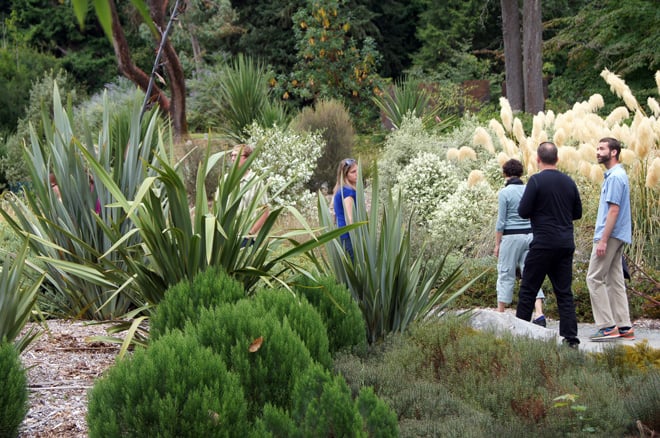
Many of the shrubs and trees in the garden display a growth pattern known as divaricate branching, their slender twigs regularly bend at right angles creating a complex tangle while leaves are reduced to less than fingernail size. Divarication, which occurs in several unrelated species, including the wire-netting bush (Corokia cotoneaster), wire vine (Muehlenbeckia complexa), dwarf kowhai (Sophora prostrata), and black pine or matai (Prumnopitys taxifolia), is thought to be another form of defense against hungry browsers, and adds to the bizarre, unworldly look of the New Zealand landscape.
With funding from the Arboretum Foundation—which has raised more than $1 million to date for the New Zealand Forest project—UWBG was able to hire horticulturist Kathleen DeMaria to care for the new exhibit. As she works with the plants, DeMaria interacts with visitors and explains the garden’s layout. She also learns from experts traveling through the region like Rebecca Stanley, Auckland Botanic Gardens curator. In an entry on the UWBG blog, Kathleen wrote about Rebecca’s encyclopedic knowledge of New Zealand native plants, seed sources, suggested reading, and contacts for New Zealand gardeners interested in the development of the UWBG New Zealand forest.
The New Zealand Forest is still in its infancy and bare earth distracts the eye, but already the extraordinary native plants have begun to knit together to create a charismatic landscape. The Maori dancers have returned home, but their legends remain carved into an Olmsted bench by native craftsman Caine Tauwharea. Visit the Pacific Connections Garden at Washington Park Arboretum and be transported half a world away—no need to bring your passport!
Arboretum Foundation Executive Director, Paige Miller’s stewardship has kept the Pacific Connections Garden project on course working in partnership with funding and project management provided by the city of Seattle.
Share:
Social Media
Garden Futurist Podcast
Most Popular
Videos
Topics
Related Posts

Ground Up Science for Greener Cities with Garden Futurist Dr. Alessandro Ossola
Spring 2023 Listen to the Podcast here. Alessandro Ossola is a scientist who gets very excited about the challenge of climate change allowing for an

Readying Urban Forests for Climate Realities with Garden Futurist Dr. Greg McPherson
Winter 2023 Listen to the Podcast here. “Going from the mow and blow to a more horticulturally knowledgeable approach to maintaining the landscape. And that

Low Maintenance Gardens – Better for Pollinators and People
Autumn 2022 “I come out every day. It’s therapy, my meditation.” Janet’s young garden transformed from overgrown, invasive plants to mostly natives. The dailiness of

Invasive Plants Are Still Being Sold: Preventing Noxious Weeds in Your Landscape
Autumn 2022 With so many beautiful ornamental plant species and cultivars throughout California and the Pacific Northwest, how do you decide which ones to include

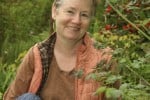









Responses